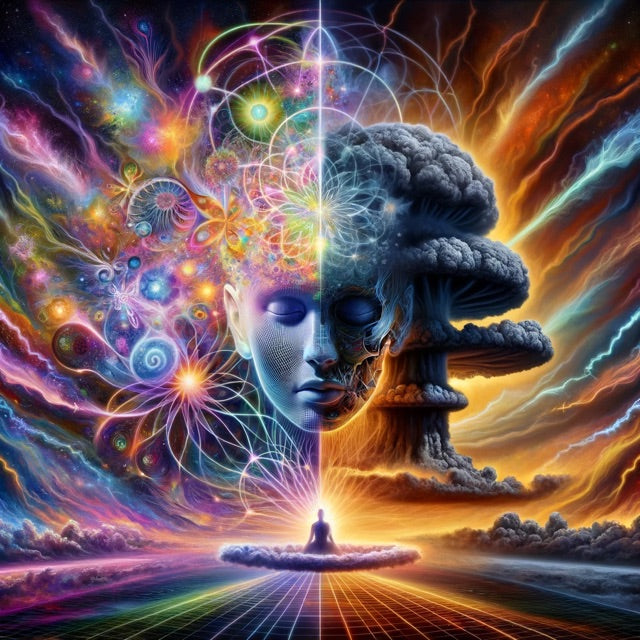In the annals of the 20th century, two discoveries stand out for their profound impact on humanity, each embodying the dualistic nature of our technological and philosophical evolution. On one hand, the creation of the nuclear bomb marked a foray into unparalleled destructive power, symbolizing humanity's capacity for catastrophe. On the other, the synthesis of LSD (Lysergic Acid Diethylamide) opened doors to unprecedented explorations of consciousness, offering insights into the depths of the human psyche. These parallel developments usher a race between enlightenment and annihilation, challenging us to reconcile our technological prowess with our spiritual and ethical growth.
The Genesis of a Dual Legacy
The nuclear bomb, born out of the turmoil of World War II and the scientific leaps of the Manhattan Project, brought humanity into the atomic age. Its first use in warfare left an indelible scar on human history, demonstrating our capacity to wield technology in ways that could potentially lead to our own extinction. The nuclear arms race that followed underscored a troubling paradox: the same ingenuity that drives our progress also teeters on the brink of our undoing.
Almost concurrently, in a less ominous but equally revolutionary laboratory setting, Swiss chemist Albert Hofmann synthesized LSD for the first time in 1938, with its psychoactive properties discovered five years later. Unlike the destructive power of the nuclear bomb, LSD promised a journey inward, offering a tool for exploring the mysteries of the human mind. The subsequent cultural and scientific exploration into psychedelics during the 1950s and 60s hinted at the potential for profound personal transformation and a deeper understanding of consciousness.
A Race of Consciousness Against Catastrophe
Today, we find ourselves in a race of consciousness against catastrophe. The nuclear threat remains a stark reminder of the potential endpoint of unchecked technological advancement, a shadow of annihilation that hangs over the collective human endeavor. In contrast, the psychedelic renaissance beckons us towards an exploration of inner space, suggesting that the solutions to our most daunting challenges may lie not in further conquest of the external world, but in a deeper understanding of ourselves.
This juxtaposition of LSD and the nuclear bomb as hallmarks of the 20th century invites a reflection on our priorities and values as a species. While one represents the zenith of our external power, the other symbolizes the untapped potential of the human mind. The question then arises: Can we harness the introspective insights offered by psychedelics to navigate the ethical minefields posed by our technological advancements?
Navigating the Crossroads
The current resurgence of interest in psychedelics for therapeutic use, spiritual awakening, and creative insight offers a glimmer of hope in this race. Research into substances like LSD, psilocybin, and MDMA is uncovering their potential to heal psychological wounds, foster a sense of interconnectedness, and inspire a deeper appreciation for life. These developments suggest that a shift in consciousness could be the key to averting catastrophe, guiding us towards a future where technology serves to enhance human well-being rather than threaten it.
The Imperative of Balance
As we stand at the crossroads of consciousness and catastrophe, the dual legacy of the 20th century serves as a powerful reminder of the need for balance. The challenge before us is to navigate the complexities of the modern world with wisdom, compassion, and a heightened awareness of our interconnectedness. By embracing the introspective journey that psychedelics offer, we may yet find the vision and empathy required to wield our technological capabilities responsibly, ensuring that our legacy is one of enlightenment rather than extinction.
In this race, the stakes could not be higher, for it is not only the future of humanity that hangs in the balance, but the very essence of what it means to be human. The path we choose now—to elevate consciousness or succumb to catastrophe—will define our trajectory for generations to come.

